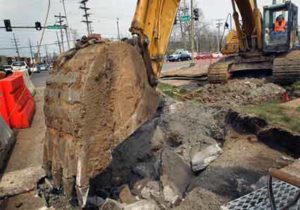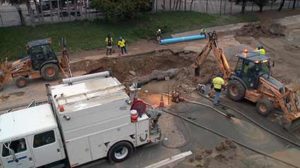Pipeline Ruptures in Missouri
Collapsing Pipelines and Sinking Roads: The Hidden Costs of Aging Infrastructure in America
Just a few weeks ago, Maplewood, Missouri found itself grappling with a massive sinkhole caused by a ruptured pipeline at a bustling intersection. The incident disrupted traffic and highlighted the vulnerability of outdated infrastructure. Similarly, San Diego recently faced a crisis when an aging cast iron water pipeline burst, causing road closures, property damage, and yet another sizable sinkhole. These events paint a grim picture: America’s water infrastructure is deteriorating rapidly, with thousands of water main breaks occurring annually.
As time progresses, millions of miles of pipelines across the U.S. grow weaker due to corrosion and wear. Replacing or repairing these systems presents a daunting challenge, especially given tight municipal budgets. According to the 2013 report from the American Society of Civil Engineers (ASCE), the country will need around $3.6 trillion over the next decade just to maintain its infrastructure. Despite this urgent need, America’s infrastructure still received a dismal grade of D+—a clear sign that we’re falling further behind in addressing critical infrastructure needs.
Missouri alone faces a staggering bill of $7.1 billion for drinking water upgrades and an additional $5.8 billion for wastewater improvements. Nationally, experts estimate that replacing all failing water mains would cost over $1 trillion. In Maplewood, the damaged pipeline was identified as a “42-inch corrugated metal pipe†installed in the 1930s. Years of exposure to moisture and chemicals had weakened it, culminating in its catastrophic failure. Recognizing this risk, Missouri American Water Co. has been actively investing in preventive measures, focusing on high-risk periods like winter and summer, when pipes are more prone to breaking. Over the last five years, they’ve replaced 141 miles of old water mains in St. Louis County and parts of St. Charles County, spending approximately $138.5 million in the process.
However, replacing entire pipelines isn’t always the most efficient solution. Alternative methods, such as those offered by HJ3’s carbon fiber repair systems, provide a cost-effective way to extend the life of existing infrastructure. These innovations use advanced materials to strengthen corroded pipes while reducing both labor and material costs. Emergency repairs often carry even higher price tags due to factors like road closures, cleanup, and lost productivity. Efficiency and affordability are key to solving this problem.
To combat these challenges, cities must adopt proactive maintenance practices that maximize their limited resources. Lance LeComb, a spokesperson for the Metropolitan St. Louis Sewer District (MSD), noted that while failures like those in Maplewood and San Diego remain frequent, taking preemptive action can help mitigate future crises. By prioritizing strategic investments in maintenance and repair, communities can avoid the far greater expenses associated with complete replacements.
â€

â€

â€
While the consequences of neglecting our infrastructure are severe, the good news is that modern solutions exist to help bridge the gap between need and funding. By embracing innovation and adopting smarter maintenance practices, we can ensure that America’s vital water systems remain resilient for generations to come.
aluminum foil wrapping paper ,aluminum foil paper roll ,aluminum foil food wrapping paper ,reasonable price aluminum paper foil roll ,low price aluminum foil paper roll
Qingzhou Xincheng Packaging Co., LTD , https://www.qzxcbc.com